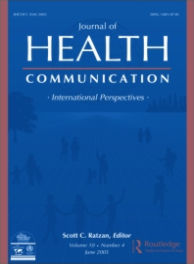
Journal of Health Communication Ebola Supplement
The Health Communication Capacity Collaborative (HC3) developed a special issue of the Journal of Health Communication, focused on Ebola. This supplement examines the successes and challenges of social and behavior change communication (SBCC) work during the Ebola epidemic.

A Framework for Health Communication Across the HIV Treatment Continuum
This is an article is from a special issue of JAIDS: Journal of Acquired Immune Deficiency Syndromes that highlights the effectiveness of health communication in keeping people engaged and on treatment throughout the HIV continuum of care – leading to more positive health outcomes. The supplement, titled Impact of Health Communication on the HIV Continuum of Care, presents a series of 10 articles that make the case for using health communication in highly diverse HIV contexts in low- and middle-income settings.

Health Communication and the HIV Continuum of Care
This is an article is from a special issue of JAIDS: Journal of Acquired Immune Deficiency Syndromes that highlights the effectiveness of health communication in keeping people engaged and on treatment throughout the HIV continuum of care – leading to more positive health outcomes. The supplement, titled Impact of Health Communication on the HIV Continuum of Care, presents a series of 10 articles that make the case for using health communication in highly diverse HIV contexts in low- and middle-income settings.

The impact of behaviour change communication on the use of insecticide treated nets: a secondary analysis of ten post-campaign surveys from Nigeria
Ahead of an ITN mass distribution campaign in Nigeria, the authors of this article conducted a secondary analysis of surveys conducted after ITN distributions between 2009 and 2012 to investigate the role of social and behavior change communication in adequate net hanging and use, and how it may influence SBCC efforts for the next campaign.

The Role of Health Systems and Policy in Producing Behavior and Social Change to Enhance Child Survival and Development in Low- and Middle-Income Countries: An Examination of the Evidence
This review provides conclusions and recommendations on the studies of evidence-based behavior change interventions that addressed health systems or policy. The author's recommendations are offered around each topic area (pneumonia/diarrhea, neonatal survival, nutrition, PMTCT, malaria, healthy pregnancies, and immunizations) that is classified by the World Health Organization Health System Building Blocks of health system delivery, health workforce and health financing, leadership and governance.

Community Engagement to Enhance Child Survival and Early Development in Low- and Middle-Income Countries: An Evidence Review
An evidence review team was organized to address the question, ‘‘What are the effective means to facilitate and empower communities to organize and advocate for interventions to achieve behavioral and social changes that are needed to accelerate reductions in under-5 mortality and optimize healthy and protective child development to age 5?’’ This article is a report from the evidence review team.

Scaling Up and Sustaining Voluntary Medical Male Circumcision: Maintaining HIV Prevention Benefits
This article asserts that, in order to maintain high circumcision prevalence, voluntary medical male circumcision programs in Eastern and Southern Africa need to plan for sustainability and conduct transition assessments early on, rather than waiting until the saturation of priority targets at the end of the program.

Enhancing Benefits or Increasing Harms: Community Responses for HIV Among Men Who Have Sex With Men, Transgender Women, Female Sex Workers, and People Who Inject Drugs
A synthesis of evidence characterizing community-level determinants and their influence on HIV-related outcomes for key populations, this systematic review revealed a limitation of studies conducted that focused on key populations in LMICs.

Role of Community-Level Factors Across the Treatment Cascade: A Critical Review
This review – the first critical review of literature that examines the role community-level factors (CLFs) play in the design of multilevel, effective and sustainable interventions that address all elements of the HIV/AIDS treatment cascade – identified 100 peer-reviewed articles based on studies in LMICs that assessed CLFs in relation to the HIV/AIDS treatment cascade.

Adolescent Sexual and Reproductive Health Services and Implications for the Provision of Voluntary Medical Male Circumcision: Results of a Systematic Literature Review
This literature review revealed a general absence of health services in Sub-Saharan Africa that addressed the needs specific to male adolescents, exposing potential knowledge gaps that could negatively influence the population's benefit from voluntary medical male circumcision (VMMC) programming.

HIV Communication Capacity Strengthening: A Critical Review
This gray literature review examined varying definitions, measurements, implementations and effects of HIV communication capacity strengthening. Based on their review, the authors make recommendations for establishing a holistic model for HIV communication capacity strengthening, among other things.
